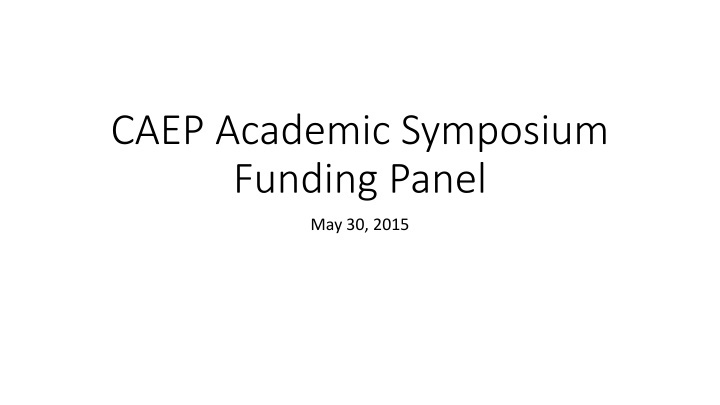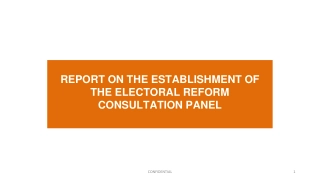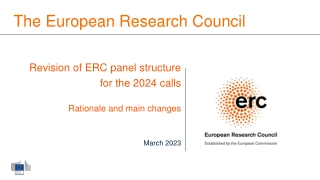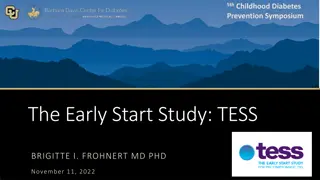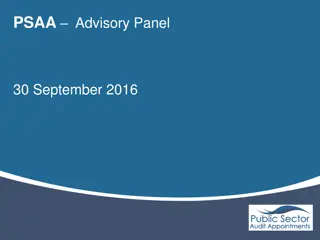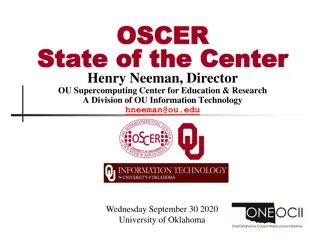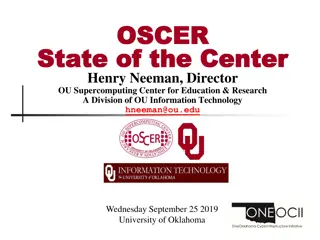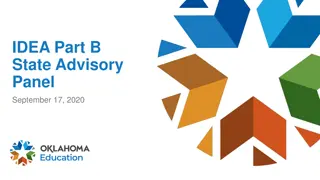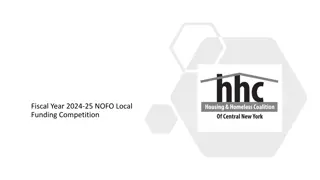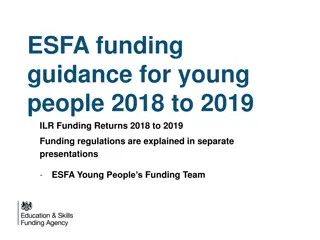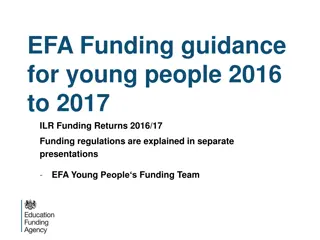CAEP Academic Symposium Funding Panel Findings
This report explores appropriate funding levels for academic emergency medicine programs in Canada. It highlights strategies for sustainable funding, benchmarking academic unit support, and developing strategic plans aligned with institutional mandates. The research process includes environmental scans, literature review, and expert interviews to create recommendations for Canadian EM units. Funding sources vary across medical schools, with support from hospitals, practice plans, ministries of health, and universities. The recommendations emphasize the importance of aligning departmental goals with broader institutional objectives.
Download Presentation

Please find below an Image/Link to download the presentation.
The content on the website is provided AS IS for your information and personal use only. It may not be sold, licensed, or shared on other websites without obtaining consent from the author.If you encounter any issues during the download, it is possible that the publisher has removed the file from their server.
You are allowed to download the files provided on this website for personal or commercial use, subject to the condition that they are used lawfully. All files are the property of their respective owners.
The content on the website is provided AS IS for your information and personal use only. It may not be sold, licensed, or shared on other websites without obtaining consent from the author.
E N D
Presentation Transcript
CAEP Academic Symposium Funding Panel May 30, 2015
Funding Panel Members Eddy Lang, Chair Jim Christenson, Leadership Working Group Chair Ian Stiell, Academic Section Executive Chair Claude Topping Francois Belanger Marc Afilalo Tia Renouf Anthony Crocco Jennifer Artz Kelly Wyatt Ryan Wilkie
WHAT WHAT IS AN APPROPRIATE AMOUNT OF FUNDING IS AN APPROPRIATE AMOUNT OF FUNDING AND HOW TO ACHIEVE AND HOW TO ACHIEVE IT? IT? To report on funding for academic EM programs across Canada To benchmark academic unit support against expectations in the areas of administration, undergraduate education, postgraduate education, and research To determine best strategies to grow and establish sustainable funding across Canadian university EM departments/divisions
Terms of Reference a) Researching their topic including environmental scans of Canada and U.S., literature review, and interviews of experts. b) Creating recommendations for Canadian Academic EM units, c) Presenting the recommendations at the CAEP 2015 Academic Symposium, d) Publishing the recommendations in CJEM.
1. Departments should develop strategic plans with missions, visions and goals ideally aligning with University, Hospital and Ministerial mandates
1. Sources for financial support varies across the 17 medical schools. 1. Sources for financial support varies across the 17 medical schools. Sources of Support 6 Hospital 7 Practice Plan 10 Ministry of Health / Alternate Funding Plan 17 University Number of Medical Schools
1. Sources for financial support varies across the 17 medical schools. 1. Sources for financial support varies across the 17 medical schools. 100% 100% Mean % Support 98% 93% *Range of support indicated by vertical line. 90% 80% 70% 65% 60% 50% 46% 40% 30% 29% 25% 22% 20% 20% 12% 10% 4% 2% 0% University Ministry of Health / Alternate Funding Plan Practice Plan Hospital
Histogram of Funding for EM Units Amount of funding for the 17 medical schools Amount of funding for the 17 medical schools 6 5 5 5 4 Frequency 3 Mean Median 2 2 2 2 Annual budget (n = 16) $1,073,180 $862,500 1 Departments only Not a department $1,547,269 $704,444 $1,600,000 $500,000 0 $1,000,000 to $2,000,000 <$250,000 >$2,000,000 $500,000 to $999,000 $250,000 to $499,000 Funding Ranges
2. These plans should address both the clinical and academic missions and be interwoven in a way that optimizes synergy and mutual benefit Avoid the creation of silos
2. 2. EM EM Status and Section/Division Affiliations Status and Section/Division Affiliations STATUS OF EM WITHIN THE 17 MEDICAL SCHOOLS Full Department 2, 12% Division/Section Joint Department with FM No Status 3, 18% 8, 47% Section / Division Affiliations (n = 4) Medicine 3 4, 23% Pediatrics 2 Family Medicine (FM) 2 Not Specified 1 Surgery 0
2. Teaching Hospitals and Faculty 2. Teaching Hospitals and Faculty 2.7 4.9 4.5 Mean Number of Associated Major Teaching Hospitals Mean Number of Other Hospitals Taking Clinical Clerks Mean Number of Other Hospitals Taking Residents 90 2.4 10.3 Mean Number of Faculty Physicians at Major Teaching Hospitals Mean Number of Associate Professors Mean Number of Full Professors
3. Develop a Business Plan that clarifies the financial resources needed to achieve the mission and goals, what the sources of income should be, and how you would spend the resources most effectively
Existing funding sources to Existing funding sources to support the academic mission in support the academic mission in e emergency departments mergency departments Response Chart Percentage Count University (via Faculty of Medicine or otherwise) 93.8% 15 Hospital 37.5% 6 Physician Group 37.5% 6 Ministry of Health or Education Ministry 43.8% 7 AFP 25.0% 4 Research Grants 68.8% 11 Other / combination * 37.5% 6 Total Responses 16 *Philanthropy, foundation, donations, University funding organization, AMOSO (MOH Ontario tithe plan), practice plan
What What are the main challenges that you have are the main challenges that you have faced in appropriate* funding for the academic mission of your appropriate* funding for the academic mission of your department? faced in obtaining obtaining department? Undergraduate education is only partially funded Low administrative support funding Academic research mission not supported under model (CCFP EMs under family practice and FRCP EMs under surgery) Increasing budgetary conditions limiting funds for new initiatives Obtaining grants is difficult AFP clinical/academic split is not as generous as other specialties No baseline funding adjustment for yearly volume increases and program growth Limited number of GFT positions, no protected academic time for non-GFT positions Lack of support from academic home Department of Medicine Department of Medicine funds do not flow to Division of EM Physicians not part of academic practice plan AFP shrinking in size
What What is the appropriate funding for undergraduate education medical is the appropriate funding for undergraduate education medical leadership and infrastructure support? leadership and infrastructure support? One representative acting on behalf of EM and UGME University solely Mixed medical school, government, region Mixed medical director provincially ($50,000), clerkship director ($40,000), teaching site coordinators ($5-15,000) Mixed MD UG director, non-MD coordinator (half-time), budget for teaching activities Mixed - 0.25 university EFT (~$50,000), with dedicated admin support $250,000 Space, admin support, and funding to support physician leads on a part-time basis for UGME At least two half days of protected time/week and one admin coordinator Have ED fund positions out of academic budget (rather than University)
What What is the appropriate funding for postgraduate education medical is the appropriate funding for postgraduate education medical leadership and infrastructure support? leadership and infrastructure support? University solely Mixed medical director provincially ($75,000), provincial administrative support (1.5 FTE), 4 CaRMS site directors ($28-40,000 each), 4 site administrators (0.5-1 FTE) Mixed medical school, government, region Mixed MD UG director, non-MD coordinator, budget for teaching activities Mixed - 0.5 EFT for FRCP Program Director and 0.3 EFT for CCFP-EM Program Director with 1.0EFT admin support $500,000 Space, admin support, and funding to support physician leads on a part-time basis for PGME At least three half days of protected time/week and one admin coordinator None funded out of ED general budget One APA in the city, several APAs rurally
What What is the appropriate hard funding for Research Faculty and is the appropriate hard funding for Research Faculty and infrastructure support? infrastructure support? Grants Awards Medical school Hospital Foundation Research institutes AFP Individual faculty members in the AFP receive support as a component of their academic contributions Specific staffing suggestions (see notes) $500,000 Salary support, protected time, admin and staff infrastructure support Research faculty should have easier access to higher university status
Would Would you consider your you consider your current administrative activities in your administrative activities in your department to be adequate? current degree of financial support for degree of financial support for department to be adequate? Response Chart Percentage Count Yes 56.2% 9 No 43.8% 7 Total Responses 16 Can Can you tell us about the funding that supports that administrative you tell us about the funding that supports that administrative requirements of your academic program? requirements of your academic program? One secretary, one APA One admin support position (funded by University) Head s contract only $450,000 Faculty sourced Hospital full time coordinator Mixed - Health region for department head. Contracted school positions for UG coordinator, PG coordinator and FRCP and CCFP EM program heads Mixed - Practice plan + University Mixed hospital, university, EHS, grants, group earnings Mixed - Residency, UG, CPD activities Mixed University and MOH Mixed University, AMOSO practice plan, hospital Mixed - Government and University Mixed - Dedicated AA for each program, business manager and assistant to dept head, all supported by Mb Health funding
What What strategies have you undertaken to achieve current levels and are strategies have you undertaken to achieve current levels and are you seeking means of bolstering it? you seeking means of bolstering it? Working closer with PhD educators to develop graduate student capacity and tri- council funding Allotting funds from multiple sources of funding for academic activities University negotiating Negotiating for increased number of academic positions Accreditation negotiating Practice plan negotiating Regional CMO negotiating for additional medical positons Attempted bypass of AFA to have OMA investigate on behalf of departments (OMA recommendations challenged but dismissed by MOH) Department recognition Using CPD programs to generate further funds Appealing to clinical groups to fund non-core expenses, eg food for grand rounds and journal club
4. Philanthropic support for the academic mission of the Emergency Department should be actively pursued primarily through hospital and/or university fund development Departmental strategic plans should serve as the basis through which philanthropic resources be engaged and pursued
Are Are philanthropic resources sought after and used to support the philanthropic resources sought after and used to support the academic mission of your academic mission of your department? department? Response Chart Percentage Count Yes 50.0% 8 No 50.0% 8 Total Responses 16 If yes, elaborate: If yes, elaborate: Donors: physicians, industry, hospital grants, endowments, patients, pharma education grants Average gift: ranged from $500 (physicians) to $100,000 (private donors and/or endowment funds) If no, elaborate: If no, elaborate: Planning to start Labour intensive Difficult to get EM donations Not on the radar
5. Encourage and incentivize clinician involvement in both clinical and academic affairs as a prerequisite to effective partnering with fund development offices in hospitals and at the university.
6. Partners sharing a common vision with EM can by myriad and include graduating residents, grateful patients or wealthy givers.
7. Academic Departments of EM need to develop guiding financial policies that address these two areas: The practical relative value of academic time to clinical remuneration should be discussed and agreed on by faculty and developed into policy The expectations for donating clinical earnings to the academic mission should be clear and agreed to by clinical groups
How didactic and bedside teaching are supported? Point system - Funds distributed based on contribution hours/points Honorarium/Stipend Shift allowances Hourly fee Teaching center expectation compensation built into job description/payment contracts
Is bedside on-shift teaching of medical students financially supported? Response Chart Percentage Count Yes 62.5% 10 No 37.5% 6 Total Responses 16
Is bedside on-shift teaching of residents financially supported? Response Chart Percentage Count Yes 75.0% 12 No 25.0% 4 Total Responses 16
Is didactic or small group teaching to residents or medical students financially supported? Response Chart Percentage Count Yes 86.7% 13 No 13.3% 2 Total Responses 15
Source of funding for medical students and residents bed-side, didactic and/or small groups teaching University Government funding - Department of Health, Minister of Health, Minster of Advanced Education for Medical Students. AFP money RAMQ (r gie de l'assurance maladie du Qu bec) PUPSR program (real and standardisez patients universitary program) Academic Funding Plan PGME funds AMOSO (MOH Ontario tithe plan) RVG (Relative Value Guide Manitoba)
Is the research component of your academic mission supported by any internal funding sources? Response Chart Percentage Count Yes 80.0% 12 No 20.0% 3 Total Responses 15 Source of funding? Grants, awards, practice plans, volunteered group clinical earnings, funding model (AFP), university, Departmental-based REdI (research, education, innovation) Fund
If on fee for service or a mixed model, do physicians contribute a portion of their clinical earnings to support the academic mission of the department? Response Chart Percentage Count Yes 55.6% 5 No 44.4% 4 Total Responses 9 If yes, elaborate: Mandatory - Percentage of earnings: Ex// 15%, 5%, 2%, $5 per hour, $2 per hour Volunteer - Matching funds contribution: funds donated are matched by MOH
Would you consider the degree of financial support that remunerates educators (for teaching) in your department to be adequate? Response Chart Percentage Count Yes 62.5% 10 No 37.5% 6 Total Responses 16 Are the clinician educators with leadership roles in your program adequately supported from a financial perspective? Yes No N/A Total Responses Program directors 9 (56.2%) 7 (43.8%) 0 (0.0%) 16 Clerkship leads 9 (60.0%) 6 (40.0%) 0 (0.0%) 15 Simulation coordinators 4 (25.0%) 11 (68.8%) 1 (6.2%) 16
What approaches would you consider relevant and appropriate to support the educational mission of your department? Clinical load relief (create teaching and learning chairs + clinical educator funding model) Consider goals and values of healthcare system + quantify the activity required to deliver the quality education program to decide on appropriate funding Lobby university and practice plans Stronger involvement of Ministry and university Show need and advancing academic department Refuse increased teaching demands without support Improved AFP Productivity based metrics that reward educational and research activities in addition to volume and acuity based clinical earnings Infrastructure in place to allow for success Faculty in place who have the expertise to develop, design and evaluate educational change Transparent university support
Would you consider the degree of financial support that supports research activities in your department to be adequate? Response Chart Percentage Count Yes 18.8% 3 No 81.2% 13 Total Responses 16 For instance, do you consider it important to have researchers that are university- funded (i.e., without any external salary support)? Response Chart Percentage Count Yes 81.2% 13 No 18.8% 3 Total Responses 16
If yes (re: salary support for researchers), what advice would you share in achieving this success? Employ the best (have demonstrated success) and work in successful departments Researchers programs should be aligned with faculty and MOD visions/mission Department at University level Awards based on qualifications and productivity Emphasize low level of fixed dollars allocated to DEM relative to other departments, research output and size of clinical/academic role in the system need sources of revenue for this, including income generation through continuing professional development, tithing and external endowments If not, what approaches do you see as being most fruitful in achieving appropriate funding / support for your research program? Develop endowments/philanthropy Matched funding between university, research institute and external grants Improved AFP Partner with industry Advocate that University should invest in EM research
Describe the obstacles and levers for success that describe your department s experience? Obstacles: Budgetary deficit Staff deficit Simulation resource deficit Bureaucratic inertia Limited understanding of EMs role in healthcare system reform Difficulty in finding external partners to better finance training activities Levers: Department income generators: High Performance Physician (HPP) Program, US training of other programs' residents, IMG training, clinical tithe Focusing on a few of the right activities Peer review
8. Academic activities need to bring value to the clinical department either through continuing medical education, faculty development or research that addresses clinical concerns if clinical income is sought to support the academic mission.
8. Academic Activities and Clinical Department (Teaching Programs) 8. Academic Activities and Clinical Department (Teaching Programs) Clerkship CCFP-EM RCPSC n = 16 n = 17 n = 14 7.3 Campuses 4.8 Teaching Hospitals 4.3 Teaching Hospitals 171 Clerks 7.6 CARMS Residents 5.5 CARMS Residents 6/16 Provide Non- clinical Teaching Shifts Off Service Residents Teaching Stipends Fellowships n = 11 n = 17 n = 17 Examples: Pediatrics, Ultrasound, EMS, Simulation, Education, Trauma, Airway 138 Residents Examples: Ultrasound, Simulation 11/17 Education Sessions 11/17 Education Director
8. Academic Activities and Clinical Department (Education Programs) 8. Academic Activities and Clinical Department (Education Programs) Education Faculty 14/17 Compensation to Reward Teaching 10/17 Host Annual CPD Conference 11/17 Host ACLS Course/WS 10/17 Host ATLS Course/WS 10/17 CPD Outreach CPD Faculty Development 13/17 Provide Faculty Development 13/17 Annual Faculty Retreats 14/17 Access to PhD Educators 8/17 Reward Faculty for Education Scholarship (Non-salary) 11/17 Provide Education Grants (Non-salary) Education Scholarship
8. Academic Activities and Clinical Department (Research) 8. Academic Activities and Clinical Department (Research) Faculty Resources 13/17 Salary-supported Researchers 14/17 Affiliated with Research Institute 13/17 Researchers with 25% Protected Time 5/17 Provide Compensation for Abstracts /Publications 7/17 Peer-reviewed Salary Awards 8/17 Provide Internal Grants (Non-salary) 15/17 Peer-reviewed Grants 15/17 Access to PhD Biostatistician 11/17 Multi-centre Studies 14/17 Database/Programming Support
9. Canadian Academic Department Heads should meet on an annual basis to share, network and grow. We found it useful Other specialties in Canada do it AACEM seems to be thriving Canadian chapter? Support staff / business managers involved as well
10. The CAEP annual meeting should offer a leadership track annually covering key funding- related topics that could include negotiating with the university, hospital and ministry, leveraging philanthropy, practice plans, entreprenership etc. Topic selection should be tied to a needs assessment drawn from engaged leaders and leaders in development.
